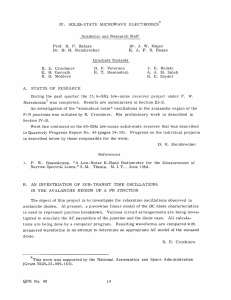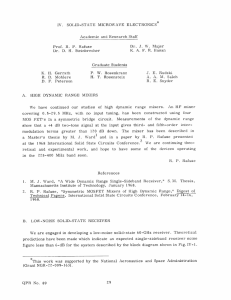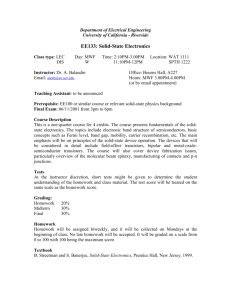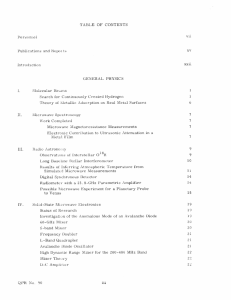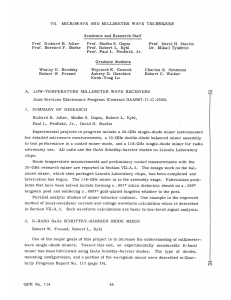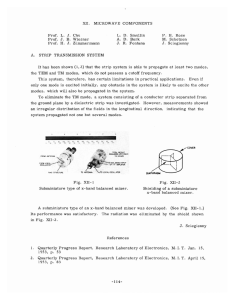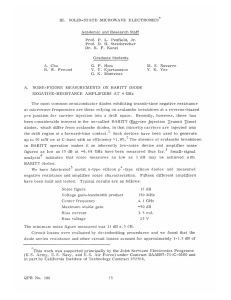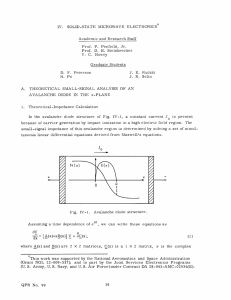Academic and Research Staff Graduate Students
advertisement
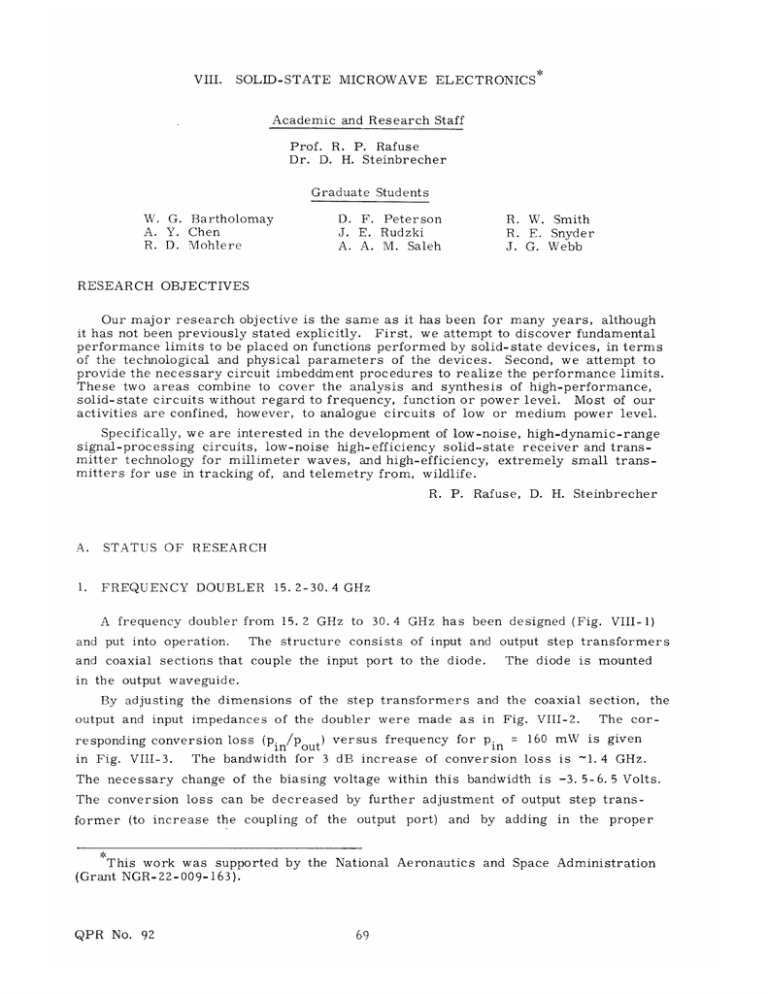
VIII. SOLID-STATE MICROWAVE ELECTRONICS* Academic and Research Staff Prof. R. P. Rafuse Dr. D. H. Steinbrecher Graduate Students W. G. Bartholomay A. Y. Chen R. D. Mohlere D. F. Peterson J. E. Rudzki A. A. M. Saleh R. W. Smith R. E. Snyder J. G. Webb RESEARCH OBJECTIVES Our major research objective is the same as it has been for many years, although it has not been previously stated explicitly. First, we attempt to discover fundamental performance limits to be placed on functions performed by solid-state devices, in terms of the technological and physical parameters of the devices. Second, we attempt to provide the necessary circuit imbeddment procedures to realize the performance limits. These two areas combine to cover the analysis and synthesis of high-performance, solid-state circuits without regard to frequency, function or power level. Most of our activities are confined, however, to analogue circuits of low or medium power level. Specifically, we are interested in the development of low-noise, high-dynamic-range signal-processing circuits, low-noise high-efficiency solid-state receiver and transmitter technology for millimeter waves, and high-efficiency, extremely small transmitters for use in tracking of, and telemetry from, wildlife. R. P. Rafuse, D. H. Steinbrecher A. STATUS OF RESEARCH 1. FREQUENCY DOUBLER 15. 2-30.4 GHz A frequency doubler from 15. 2 GHz to 30. 4 GHz has been designed (Fig. VIII-1) and put into operation. The structure consists of input and output step transformers and coaxial sections that couple the input port to the diode. The diode is mounted in the output waveguide. By adjusting the dimensions of the step transformers and the coaxial section, the The coroutput and input impedances of the doubler were made as in Fig. VIII-2. responding conversion loss (Pi/pout ) versus frequency for pin = 160 mW is given in Fig. VIII-3. The bandwidth for 3 dB increase of conversion loss is ~1.4 GHz. The necessary change of the biasing voltage within this bandwidth is -3. 5-6. 5 Volts. The conversion loss can be decreased by further adjustment of output step transformer (to increase the coupling of the output port) and by adding in the proper This work was supported by the National Aeronautics and Space Administration (Grant NGR-22-009-163). QPR No. 92 ..... .......... ................ .. .................. .. .... ....................... . ~~ . ........ __( ... :,: -, _ ... ~~ ' ' '~ ( ( .............. ( ........ ~ ';: : ..... ....... ...... I . :,:....... ...... ~ ~ ~~~.................. ..... ...... ..... ....... ... .................. . . . ~ ............ ... :, * .... . .. - .. ~ . ...... ~ ... . ..... ..... ~~~... . .....~ .. ....................... ..... . . ... :.....:.......... . ............. ... .... ....................... ....I. ~~ ................. : ........ .. . I........... - .... .. . ..... , '* ....... '': .... .. .. ... ~: - *:.... .... .. ....... ~.. ......... ....... ...... ............ . .................... . I....... .............. ..... ......... .......... .... ....... :......... ......... ...... . . ......... ......... .. . .... ............... ......... ... ...... . ..................... ... i .. ............... .. ..... -...... -.- - :......... .., ... ..........- I............. .. ................. ~.................... .... ... ..... ...... ................... ...... - ..... ....: ....... .. . . . . . . . ........... . . . . . . . .. . . . .. ......... ::: ::: .... .... ... .... .... ....... : :.... : . . .. . .... ......... ............. .......... : : :: :::............... : .:....I .................... i j.... : : : : : : :: ... ..... I ..... ...... I ... ..... ............ ..........................w Fig. VIII-2. QPR No. 92 : : :: :: :: : :: : : : : : : : ) Input and output impedances vs biasing voltage of the frequency doubler. 10- 140 145 150 155 160 F (GHz) Fig. VIII-3. Conversion loss vs frequency of the frequency doubler. Fig. VIII-4. Input and output impedances of the frequency doubler with EH tuners at input and output ports. QPR No. 92 (VIII. SOLID-STATE MICROWAVE ELECTRONICS) place reactive elements (posts or irises) at input and output. An unwelcome consequence of this would be a decrease in the bandwidth. By placing EH tuners at the input and output ports, the input and output impedances were modified according to Fig. VIII-4. The conversion loss was 5. 3 dB (efficiency 29. 5%), the bandwidth 80 MHz. J. W. Majer 2. L-BAND QUADRUPLER Two years ago, theoretical solutions for all-idler punch-through varactor multipliers 2 were presented.1 An experimental verification of the theory has now been completed. Computer-aided circuit analysis was used to synthesize an imbedding network that presented the punch-through varactor with the optimum impedance-frequency characteristics Fig. VIII-5. Experimental 0. 9-GHz punch-through varactor quadrupler. multias predicted by the theory. The resulting circuit is shown in Fig. VIII-5. The capaplier efficiency was 53% as compared with 52% calculated, and the power-handling bility was within agreement with theory. The maximum L-band output power was 8 W. QPR No. 92 (VIII. A rent sampling resistor was waveform. A included comparison e5 SOLID-STATE MICROWAVE ELECTRONICS) in the of theoretical MEASUREMENT Pin= 6 Watts 4 circuit and to monitor the varactor cur- experimental values for the FOR 3 -J S- MEASURED 01r - o Fig. VIII-6. varactor is current given in I , 11 CALCULATED -2 Calculated and measured varactor current waveforms. waveform Fig. VIII-7, is displayed both with A: QUADRUPLER B: QUADRUPLER and in Fig. VIII-6. without the Efficiency vs input power 0. 5-Q sampling WITHOUT SAMPLING RESISTOR WITH SAMPLING RESISTOR 30 4.0 40 - @ I-I 0.5 1.0 INPUT Fig. VIII-7. ance vs bias sampling contours resistor. QPR No. 92 z O0 0.2 resistance -J 5.0 6.0 20 series ULn 0 - 30 0. 9-0 The 2.0 -0 50 resistor. I I I 2.0 5.0 10 cr z 7.0 0 20 POWER (Watts) Efficiency vs input power for the quadrupler. of the at the diode was multiplier obtained output from the (Fig. VIII-8), small-signal imped- with and without the (VIII. SOLID-STATE MICROWAVE ELECTRONICS) fo = 900MHz Fig. VIII-8. Small-signal output impedance vs bias voltage. The experimentally obtained current waveform was analyzed and the harmonic content was found to be in excellent agreement with the results determined theoretically. K. H. Gerrath References 1. D. H. Steinbrecher, Ph. D. Thesis, Department of Electrical Engineering, M. I. T., July 15, 1966. 2. K. H. Gerrath, "The Design and Realization of Varactor Multipliers for the VHFUHF Range," S. M. Thesis, Department of Electrical Engineering, M. I. T. , September 1968. B. TASKS IN PROGRESS 1. AVALANCHE-TRANSIT -TIME OSCILLATOR ANALYSIS An avalanche diode oscillator with separate tuning of both the fundamental and second-harmonic frequencies is being investigated. The frequencies were separated in order to observe any variations in the noise and output power of the fundamental which might be caused by higher harmonic tuning. The fundamental (9-11 GHz) QPR No. 92 (VIII. SOLID-STATE MICROWAVE ELECTRONICS) was taken out through a coaxial lowpass filter and tuned appropriately, while the second harmonic (18-22 GHz) was tuned by a K-band adjustable waveguide backshort. The low- pass filter essentially isolates the two frequencies. The experiment consisted of tuning the fundamental for maximum output power with a matched load on the high-frequency port, and then replacing this load with the adjustable short and observing any changes in power and noise as the position of the short was varied. The power-level variations were not large (2-3 dB), was rather marked. but the noise performance The spectrum could be greatly enhanced or degraded at certain positions of the short. Apparently, both the second and third harmonics affect the output, S E S2.4dB SWORST 3: \ I 0.3 dB WORST 80 mW . 1 CASE BEST CAE AVERAGE NOISE ICASE X2,g/2 PICTURENO. WORST CASE 3 BESTCASE AVERAGE 4 2 POSITION OF SHORT, x Zs =jZ o tan(B 2 x +(0) 1. MATCHED LOAD 2. AVERAGE 4. BESTCASE 3. WORST CASE BANDWIDTH = 1 MHz DISPERSION = 10 MHz LINEAR SCALE Fig. VIII-9. QPR No. 92 Illustrating changes in noise performance vs secondharmonic tuning as seen on a spectrum analyzer. (VIII. SOLID-STATE MICROWAVE ELECTRONICS) since the output performance repeated itself at half-waveguide wavelengths of these frequencies. Also, there is a correlation between the power-level drop and the noise performance, as seen in Fig. VIII-9. The graph is the approximate effect for each of three Varian Associates diodes used in the circuit. changes in noise performance, They all exhibited a power-level droop and but some were worse (or better) than others. Detuning the fundamental usually results in a poorer noise performance, but it can be improved again by retuning the second harmonic. D. F. Peterson 2. 60-GHz MIXER Pending completion of the machining of the balanced mixer diode mounts, a singleended mixer was constructed and tested. With the image frequency terminated with the source impedance and the sum frequency reactively terminated (less than ideal conditions), a double sideband noise figure of 25 dB was measured, by using a 5. 5-dB noise figure IF amplifier. Significant improvements are expected in the balanced mixer with the proper terminations. J. E. Rudzki 3. MIXER ANALYSIS For any nonideal diode model both the single-ended Y mixer and the balanced G mixer show a dependence of the conversion loss on the source impedance. The question is, "How sensitive is that dependence?" It has been shown by using a simple diode model that for a given source o mixer is superior to the Y mixer. impedance and the same diode the The waveform driving the diode in the Y-mixer circuit was a rectangular pulse with a nonzero width, which is a function of the diode and the source impedance. This has proved to be the best drive waveform from all classes of real waveforms. The G mixer was assumed to be driven with a square wave (pulse duty ratio one-half) which was the optimum drive for this mixer with any diode and any source impedance used; this is another advantage of the G mixer. The question of intermodulation distortion in a doubly balanced broadband mixer, caused by the switching of the diode by the signal, was investigated. We found that a nonlinear memoryless transfer function followed by an ideal mixer is equivalent to the actual mixer circuit. distortion. This facilitates the calculations of the amount of the nonlinear Investigations are now taking place to compare the aforementioned mecha- nism of distortion with other mechanisms. A. A. M. Saleh QPR No. 92 (VIII. SOLID-STATE MICROWAVE ELECTRONICS) C. NEW TASKS 1. INTERMODULATION DISTORTION IN MIXERS We desired to build a spectrum analyzer whose principal function is the measurement of intermodulation distortion in mixers. The device should be capable of measuring the IM products accurately down to very low levels. Spectrum analyzers that are now available have limited dynamic range and inaccurate readings, for several reasons that will be discussed here. The most severe test of the IM distortion of a device is the measurement of the output with a two-tone signal applied to the input. Then, in the frequency spectrum, the IM products will appear at evenly spaced intervals on either side of the primary outputs. In this context the term "primary outputs" refers to the output of the device that would result if the device were ideal. The actual generation of the two-tone signal can be most critical, as any coupling between the signal sources will result in IM products at the input, and the output measurements of the device under test will suffer unwarranted degradation. Another problem in the measurement of IM distortion is the close proximity of the IM products to the primary output of the device under test. The measuring or display instrument is then faced with the problem of accurately giving a readout of a small signal in the presence of a large signal, under the assumption that the device under test has any efficiency at all. Because of dynamic range limitations, the accuracy of this measurement in most instruments is usually negligible when there is more than 70 dB difference between the primary outputs and the IM products. These difficulties will be eliminated by the utilization of a bridge technique in the insertion and extraction of test frequencies. The bridge will utilize sum and difference properties of hybrids to yield an output consisting of IM products only. The manner in which the inputs are divided and the outputs summed practically eliminates any degradation in the distortion measurement because of imperfect isolation between the two signal sources. The elimination of the primary outputs in the display means that IM products can be measured to much lower levels without increasing the dynamic range of the equipment. Thus far, 6 hybrids have been built with isolation between ports of greater than 35 dB to 100 MHz and 20 dB at 150 MHz. Insertion loss is less than 2 dB per branch, and VSWR is close to 1. 2. R. D. Mohlere 2. HIGH-POWER 60-GHz SOLID-STATE SOURCE The diagram in Fig. VIII-10 GHz solid-state QPR No. 92 source. illustrates the last two stages of a Multiplier designs have been completed and 100-mW 60tested and ELECTRONICS) (VIII. SOLID-STATE MICROWAVE QUADRATURE 60-GHz solid-state source. Fig. VIII-10. construction details are HYBRIDS being worked out. A. Y. 3. NONLINEAR Chen CIRCUIT THEORY Three network elements, R, L, and C, relate the terminal variables v and i, and their derivatives and integrals, as follows: 2 dv dt 2 dv dt f vdt ff vdt 2 di R L C R L C R (i) L(i) C(q) R(q) L C R dt 2 di di dt i f idt ff idt It can be shown, from energy methods, that many of these relationships cannot exist 2 physically; for instance, an element relating d 2v/dt to i is unrealizable, since when it is connected in parallel with a linear resistor it becomes a source of infinite energy. In fact, it appears that only the four elements R(i), L(i), C(q), and R(q) are realizable. This suggests work in two areas. First, it should be possible to construct a proof that these four elements, and only QPR No. 92 (VIII. SOLID-STATE MICROWAVE these four, are realizable. R(q) dX dq ELECTRONICS) Second, the element R(q), which has the relationship v i may explain those phenomena that are not now handled by nonlinear network theory, such as hysteresis. The justification for this statement is simply that if there are only 4 realizable elements, and since three of them are not sufficient to describe hysteresis, then the fourth one must. R. G. Webb D. UNDERGRADUATE PROJECTS Several undergraduate projects are under way at the present time. One of these is the design and construction of a FET bridge which will behave as a linear modulator at 9 MHz. At the present time, the bridge works, and within reasonable limits the distor- tion is relatively low. Another project is associated with the log I vs V characteristics of Schottky-Barrier diodes for use in two mixers, 50 0 and 200 S0. Included in this project is the construction of an instrument to display these characteristics over a range of 6 or 7 decades. The other project is to construct a digital display system for the indication of wind velocity. D. H. Steinbrecher QPR No. 92
